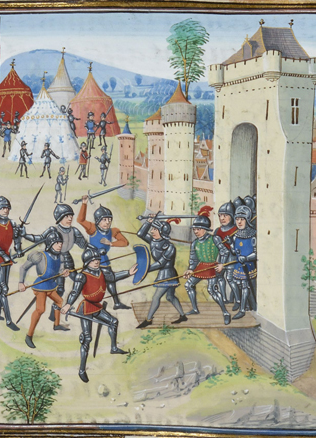The Three Martyrs of Vilnius: Conflict of Religion and Politics
Do You Know?
The three martyrs of Vilnius are the saints Anthony, John and Eustathius of the Russian Orthodox Church, tortured and executed on the order of Algirdas, Grand Duke of Lithuania. They are believed to have been martyred in Vilnius about 1347.
The old legend confirmed by newly discovered sources
In the historical context of the old Lithuania, this incident was regarded as most unusual; its historicity has been questioned for a long time. The existence of Christian martyrs seemed highly implausible in pagan Lithuania, famous for religious tolerance.
Do You Know?
It is mentioned in the Orthodox sources the pagan Lithuanians, unlike Christians, did not grow a beard or hair. “Those fire worshippers adhere to the custom introduced by their father, who was a hater of all goodness and an insidious demon, to cult their long hair short and use shavers to cut their beards.”
The description of martyrdom was known from the late historical sources, therefore it was assumed that the event was merely a medieval legend, told by the Moscow writers in the attempt to discredit Lithuania’s Rulers (and their ancestors) as persecutors of Christians. However, after the discovery of early historical sources, dating back to the second half of the 14th century, was made in the second half of the 20th century, historians became convinced that the martyrdom in question must have been a real historical event. Various interpretations emerged. Some historians upheld an opinion that the three martyrs might have been related to the supporters of the Lithuanian Grand Duke Jaunutis (1342–1345), executed after the state coup, after which Algirdas and Kęstutis came to power. Other historians claimed that the event must have happened about 1370, when the war was waged between Lithuania and Moscow and therefore the issue of political and religious loyalty was particularly sensitive. Such interpretations cannot be proven due to the lack of conclusive links between sources. A more viable interpretation of this martyrdom would be an attempt to explain it in the context of social history, which fits well with the prospect of martyrdom description. Such a context does not give us any clues as to the intricacies of the great international politics or intrigues of foreign countries. However, this context highlights a close, even intimate environment of the Lithuanian Grand Duke. In this respect, the description of the three Vilnius martyrs should be regarded as exceptional among other early Lithuanian historical sources. This text represents hagiography (biographies of saints) and deals with the style and distinctive means of expression characteristic of it. Those means of expression prompt us not to believe every word.
Uncompromising faith
Do You Know?
The description of martyrdom makes it clear that the brothers Anthony and John came from the country of Lithuania and worshipped the fire as their other fellow countrymen. Secretly having taken baptism, they converted to Christianity and “lived as befits Christians. They served the Lithuanian Duke who worshipped the fire and was not aware of their Christian faith.” At that time, Christianity was not treated as the faith manifested by both internal and external conversion and not as a private matter. Changes of the brothers’ lifestyle drew the attention of the Ruler and surrounding pagans. They made themselves conspicuous by growing beards and wearing long hair, which was not characteristic of pagans. This pagan custom seems to have particularly stirred the imagination of Orthodox writers. The versions written in the end of the 15th century by them describe it as follows: “Those fire worshippers adhere to the custom introduced by their father, who was a hater of all goodness and an insidious demon, to cut the long hair short and use shavers to cut their beards.”
The three youths were arrested for preaching in public and were ordered by Algirdas to consume meat in his presence during an Orthodox lent. When they refused, they were tortured and imprisoned for having challenged pagan customs.
The fact they were made to eat meat under coercion and their refusal to submit is repeated more than once, therefore this could be regarded as a metaphor of spiritual struggle. It does not necessarily have to be fictitious. Christians are known to have become martyrs in the Early Middle Ages after having refused to consume the meat served by pagans. Analogous situations could have also occurred in pagan Lithuania, yet special conditions were required for that. One of them was proximity of would-be martyrs to the ruler. The loyalty characteristic of the immediate environment, inherited from the military ethos, provided favourable conditions for Algirdas and his closest aides to resort to violence against the Christians who found it difficult to adjust to the customs regarded as mandatory within the group they belonged to. An uncompromising behaviour displayed by the brothers resulted in their execution, Anthony was hanged on 14 January, John on 24 April. The third martyr Eustathius was exposed to an even greater suffering and torture. Having understood that Eustathius was a Christian, the pagans tortured him pouring cold water in bitter winter frost, mutilated and finally hanged him. Not all pagans approved of such atrocities. In this context, the following description of the behaviour manifested by Algirdas’ Orthodox sons is of great interest: “Enlightened by the new faith, the torturer’s sons secretly removed his remains at night….and worthily buried them together with the above mentioned saint martyrs, who had been known for doing magic and healing.”
The torturer contributed to strengthening the cult of the martyrdom
After the martyrdom, a local cult of these martyrs began, to transform into an international cult in the course of time. In 1374, the particles of the martyrs remains were taken to Constantinople, where a ceremonious reception by the Patriach Philotheus was held. Algirdas realized that the new martyrs could be politically beneficial for him and contributed himself to erecting a wooden Orthodox church in the place of the martyrdom. Presumably, a brick Orthodox church of the Blessed Trinity Church in Vilnius was built in the place of the martyrdom in 1514, which has survived until our days.
The martyrdom of Anthony, John and Eustathius served to establish contacts between Lithuania and Byzantium.
About 1374 the first liturgical texts were created in the Greed language, the only surviving version of which is the translation into the Church Slavonic language. Somewhere in between 1394 and 1397 Michael Balsamon created A Word of Praise in their honour. The martyrs’ images adorned the pallium/vestment of the Metropolitan of all Rus’ Photius. In the 15th century, their life descriptions spread from Serbia and Bulgaria to north-eastern Rus’. Even today, the martyrs are regarded as Lithuania’s most precious treasure. Their remains, newly discovered in the 19th century, attract numerous pilgrims to remains the Orthodox church of the Holy Spirit in Vilnius.
Literature: D. Baronas, Trys Vilniaus kankiniai: gyvenimas ir istorija (istorinė studija ir šaltiniai), Vilnius: Aidai, 2000.
Darius Baronas


